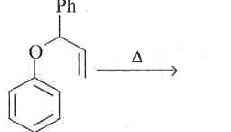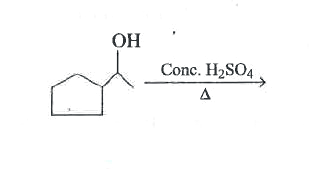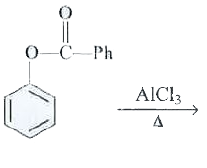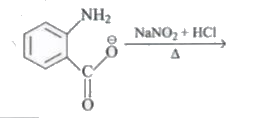Which of the following reactions involve a decrease in the length of the carbon chain:-
Schmidt reaction
Hofmann's bromamide reaction
Hell-Volhard-Zelinski reaction
All of these
The correct Answer is:A, B
To determine which reactions involve a decrease in the length of the carbon chain, we need to analyze each reaction provided in the question.
1. Understanding the Reactions:
- We need to identify reactions that lead to a reduction in the number of carbon atoms in the reactants compared to the products.
2. Smith Reaction:
- The Smith reaction involves the conversion of a carbonyl compound (like benzoic acid) to an amine (like aniline).
- Example: Benzoic acid (C7H6O2) reacts with hydrozoic acid (HN3) in an acidic medium to form aniline (C6H5NH2).
- Here, we start with 7 carbon atoms in benzoic acid and end up with 6 carbon atoms in aniline.
- Conclusion: This reaction results in a decrease in the carbon chain length.
3. Hoffman Bromamide Reaction:
- This reaction involves the degradation of amides to primary amines using a strong base and bromine (Br2).
- Example: An amide (RCONH2) reacts to yield a primary amine (RNH2) with one less carbon atom.
- Conclusion: This reaction also results in a decrease in the carbon chain length.
4. Hell-Volhard-Zelinsky (HVZ) Reaction:
- This reaction involves the halogenation of the alpha carbon of a carboxylic acid.
- Example: A carboxylic acid (RCOOH) reacts with bromine (Br2) in the presence of red phosphorus, resulting in the alpha-bromo carboxylic acid.
- In this case, the number of carbon atoms remains unchanged as we are substituting a hydrogen atom with a bromine atom.
- Conclusion: This reaction does not decrease the carbon chain length.
5. Final Answer:
- The reactions that involve a decrease in the length of the carbon chain are:
- Smith Reaction
- Hoffman Bromamide Reaction
Summary:
The answer to the question is that the Smith Reaction and the Hoffman Bromamide Reaction involve a decrease in the length of the carbon chain.
- We need to identify reactions that lead to a reduction in the number of carbon atoms in the reactants compared to the products.
- The Smith reaction involves the conversion of a carbonyl compound (like benzoic acid) to an amine (like aniline).
- Example: Benzoic acid (C7H6O2) reacts with hydrozoic acid (HN3) in an acidic medium to form aniline (C6H5NH2).
- Here, we start with 7 carbon atoms in benzoic acid and end up with 6 carbon atoms in aniline.
- Conclusion: This reaction results in a decrease in the carbon chain length.
- This reaction involves the degradation of amides to primary amines using a strong base and bromine (Br2).
- Example: An amide (RCONH2) reacts to yield a primary amine (RNH2) with one less carbon atom.
- Conclusion: This reaction also results in a decrease in the carbon chain length.
- This reaction involves the halogenation of the alpha carbon of a carboxylic acid.
- Example: A carboxylic acid (RCOOH) reacts with bromine (Br2) in the presence of red phosphorus, resulting in the alpha-bromo carboxylic acid.
- In this case, the number of carbon atoms remains unchanged as we are substituting a hydrogen atom with a bromine atom.
- Conclusion: This reaction does not decrease the carbon chain length.
- The reactions that involve a decrease in the length of the carbon chain are:
- Smith Reaction
- Hoffman Bromamide Reaction
The answer to the question is that the Smith Reaction and the Hoffman Bromamide Reaction involve a decrease in the length of the carbon chain.
Topper's Solved these Questions
- ALKENE, ALKANE & ALKYNE BOOK - ALLENCHAPTER - ALKENE, ALKANE & ALKYNE EXERCISE - EXCERSISE-3
28 Videos
- ALKENE, ALKANE & ALKYNE BOOK - ALLENCHAPTER - ALKENE, ALKANE & ALKYNE EXERCISE - EXCERSISE-1
25 Videos
- AIIMS 2019BOOK - ALLENCHAPTER - AIIMS 2019EXERCISE - CHEMISTRY
40 Videos
- ALKYL AND ARYL HALIDEBOOK - ALLENCHAPTER - ALKYL AND ARYL HALIDEEXERCISE - EXERCISE-05 (B)
35 Videos
Similar Questions
Knowledge Check
Which of the following reactions involve rearrangement?
A B
B C
C D
D
Which of the following reactions involve hydride ion transfer?
A2H−O∣∣C−HϴOH−−→H−O∣∣C−ϴO+CH3−OHB2H3C−Ot∣∣(C)−ϴOH−−−−−→ΔH3C−CH=CH−O∣∣C−HC2H3C−O∣∣C−HAl(OEt)3−−−−−→CH3−O∣∣C−O−CH2CH3D
Which of the following reactions involve benzyne intermediate?
A B
B C
C D
D
Which of the following reaction is not involved in thermite process?
View SolutionWhich of the following reaction is not involved in corrosion of iron?
View SolutionWhich of the following reaction involves homogeneous reduction ?
View SolutionWhich of the following reactions involve free radical as intermediate?
View SolutionWhich of the following reactions does not involve decarboxylation?
View Solution
